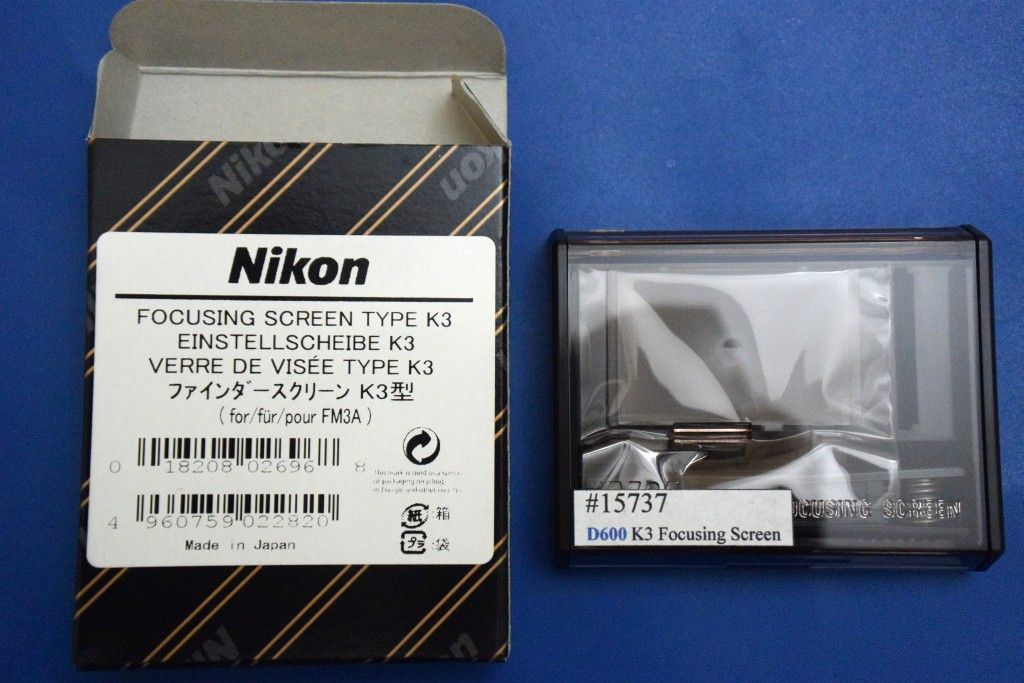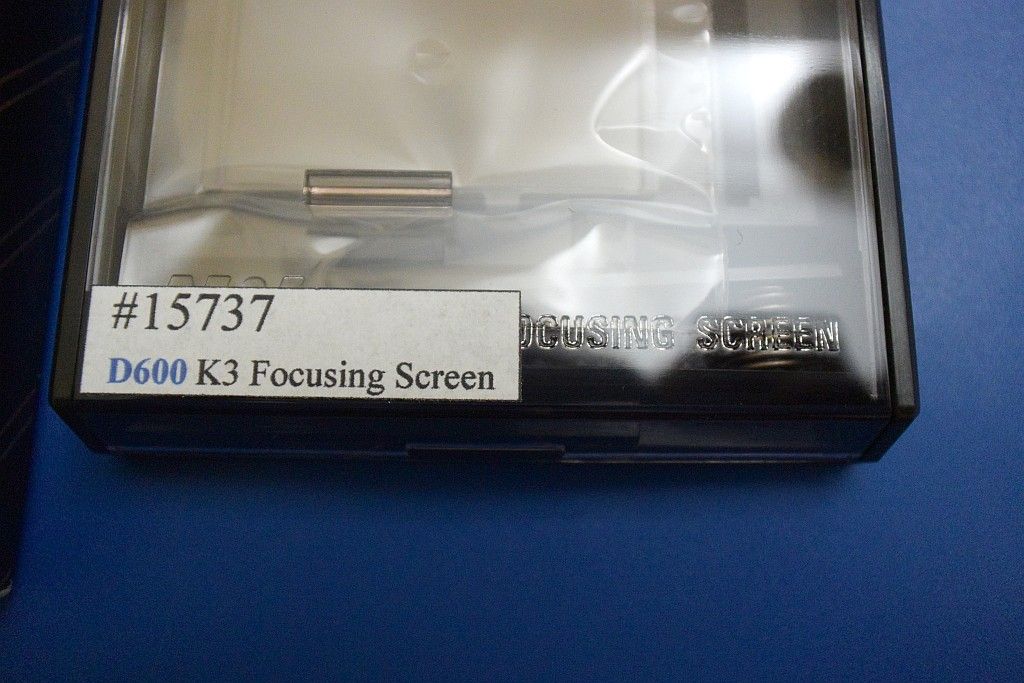
Custom Search
Howdy, Stranger!
It looks like you're new here. If you want to get involved, click one of these buttons!
Categories
- 3.4K All Categories
- 35 Nikon Z lenses
- 80 Nikon Z cameras
- 1.4K Nikon DSLR cameras
- 11 Df
- 237 D6x0/D7x0/D8x0
- 27 D300/D300s/D500
- 29 D3x00
- 45 D3/D4/D5
- 31 D5x00
- 94 D90/D7x00
- 387 Nikon Lenses
- 9 Videos, Nikon et. al.
- 52 Nikon 1
- 18 Nikon Film Cameras
- 56 Nikon Flashes
- 25 Nikon Compact Cameras
- 49 Nikon Software
- 26 Nikon Deals
- 767 General Discussions
- 49 Gear Reviews
- 182 Other Manufacturers
- 105 Fun & Weird
- 128 Photo-a-day
In this Discussion
Who's Online (2)
- photobunny 3:21AM
- Rmologic 3:23AM
Split-Image/Microprism Focusing Screen For D600
 Spy_Black
Posts: 79Member
Spy_Black
Posts: 79Member
Check this out. I finally got around to purchasing a focusing screen for my D600 from the Taiwanese company FocusingScreen.Com. I had read a while back that some folks had installed them with no problems, so I jumped in and got one.
Here's the weird thing. As far as I can tell, this is a standard issue Nikon focusing screen for the FM3A. I haven't tried to install this yet (will try tomorrow), but has this company simply realized that this standard issue Nikon screen drops right into modern Nikon bodies? The website sells this and other type screens for every single modern Nikon camera, and I can't help but feel this particular screen (type K) is the same screen for all of them.
So assuming this will indeed drop right in (if not it was a $100 gamble on my part), why does Nikon not sell these outright themselves for their cameras? This is especially so for the Df. Because if this is so, it's much cheaper to buy this screen from Nikon and just drop it in. It's listed at B&H for $36! If this indeed the case I have to say I give props to these Taiwanese people for having the smarts to capitalize on this. As long as it works I don't care that I spent almost 3 times as much, because who knew otherwise?
Have a look at the images below. The first is everything that was sent with the order, and the others are close-ups of the back of the box and case, where you can clearly see it's a standard issue Nikon case. Your thoughts?



Here's the weird thing. As far as I can tell, this is a standard issue Nikon focusing screen for the FM3A. I haven't tried to install this yet (will try tomorrow), but has this company simply realized that this standard issue Nikon screen drops right into modern Nikon bodies? The website sells this and other type screens for every single modern Nikon camera, and I can't help but feel this particular screen (type K) is the same screen for all of them.
So assuming this will indeed drop right in (if not it was a $100 gamble on my part), why does Nikon not sell these outright themselves for their cameras? This is especially so for the Df. Because if this is so, it's much cheaper to buy this screen from Nikon and just drop it in. It's listed at B&H for $36! If this indeed the case I have to say I give props to these Taiwanese people for having the smarts to capitalize on this. As long as it works I don't care that I spent almost 3 times as much, because who knew otherwise?
Have a look at the images below. The first is everything that was sent with the order, and the others are close-ups of the back of the box and case, where you can clearly see it's a standard issue Nikon case. Your thoughts?



Disclaimer: This site has no affiliation with Nikon Corporation or any of its subsidiary.
Disclosure: [NR] is sponsored by displaying advertising banners and links.
All trademarks and brands belong to their respective owners.
Want to advertise on NikonRumors.com? Contact [NR].
Copyright © 2008-2017 NikonRumors.com.
See our Privacy Policy.
Disclosure: [NR] is sponsored by displaying advertising banners and links.
All trademarks and brands belong to their respective owners.
Want to advertise on NikonRumors.com? Contact [NR].
Copyright © 2008-2017 NikonRumors.com.
See our Privacy Policy.

Comments
Being a photographer is a lot like being a Christian: Some people look at you funny but do not see the amazing beauty all around them - heartyfisher.
I didn't need the tools to install it. Their instructions are bad. There is a youtube video on how to install it.
Good to know that the focusing screens from focusing screen.com works. I have been considering getting one for my FX camera.
We are too spoiled by AF .. having good MF technique can be faster focusing than AF ! below is a dragonfly in FLIGHT taken with MF and my S5pro with focusing screen. I have a few more pics of several dragonfly in flight. just incase you think its a one off , I will have to find them, its been a while, I have been lazy to photograph more. :-)
Being a photographer is a lot like being a Christian: Some people look at you funny but do not see the amazing beauty all around them - heartyfisher.
Notice that the legs are tucked in behind the head when in flight. Thats how you know that someone has photoshopped a standing dragonfly and made it "fly" !!
Being a photographer is a lot like being a Christian: Some people look at you funny but do not see the amazing beauty all around them - heartyfisher.
I am SOOO happy I put this screen in.
Gives a whole new meaning to BIF, bugs in flight!
Because of the nature of this surface, I wonder how well an AF system would have worked with this depth of field. It would have focused, but not necessarily on the fly. That's the beauty of the older focusing screens versus the modern ones, images "pop" into focus on the groundglass. I forget exactly why they use the screens they use now, but it seems to me to not make any sense.
You can also order a plain groundglass for your camera if you feel confident enough to work with just that.
It would be good to hear about your experiences with your screen. Which brand did you get?
Thanks. I'm looking forward to more reviews.
I think in retrospect I would have just ordered the full matte, "S"-model screen and done without the split-image/microprism focusing aid, as I tend to use the matte area more often than not. The split-image/microprism aid does come in handy sometimes, mostly with macro work and generally when on a tripod.
Using focal lengths 35mm and shorter always requires more racking, regardless of screen type. My 20mm f/4 was always a challenge even on my old E and K screens on my F and F2 bodies. It was impossible to focus my 20mm with the native D600 screen, now I can at least rack.
The advantage of that configuration is that even for dim lenses (say f/5.6 max aperture) the viewfinder is relatively bright—brighter than you'd expect if you had a ground glass focus screen in, for example.
The disadvantages of the modern setup are that for bright lenses the viewfinder doesn't do the lens justice in terms of brightness, and everything looks more or less in focus because you're essentially looking at the view you would have through a pinhole camera (mostly just the center of the lens). This can be an advantage for those oh-so-common situations like when you're taking macro butterfly shots and someone steals your bike in the background. You need to see that so you can refocus and get a picture to show the police!
A split-prism focus screen acts like an in-camera rangefinder: one half redirects light coming from one side of the lens to the user's eye and the other half the other. When the lens is in focus, the light from both sides of the lens comes from the same part of the split-prism, so the lines in the image "match up" and you know you've nailed focus.
Ground glass ditches the prisms to redirect light in all directions from all parts of the lens (as close to an ideal diffuser as it can be). What you see is then exactly what you get on the whole screen.
Hooray for @Capt_Spaulding! There, I said it. To answer your question, the AF system of the camera is actually below the mirror of your SLR. There's a secondary mirror behind the primary mirror that flips up against it during exposure. The bottom line is that your camera's AF system doesn't care or even know what focus screen you have installed. The viewfinder will still display the focus spot selection and everything else that it normally does, because the LCD is unaffected by the focus screen.